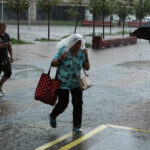Moscow has been hit by abnormal tropical downpours, thunderstorms, and hail. According to weather forecasts, on July 4, up to half of the monthly average rainfall is expected, with heavy showers in some areas continuing until the end of the day. Due to strong winds with gusts of up to 17 m/s, a storm warning has been issued in Moscow and the Moscow region. Footage from eyewitnesses shows that Vyborgskaya Street in the capital is flooded—water is knee-deep, and cars are practically floating.
A similar situation is occurring in Ramenskoye, Moscow region. A local resident shared: « After every heavy rain, the roads get severely flooded. The storm drains simply can’t cope. The water does eventually recede, but not immediately. The situation on the roads has improved for now: most of the water has drained through the sewers, and there are fewer puddles. For me personally, such flooding isn’t critical—my car’s clearance allows me to drive through. But if the rain had lasted all day, I think the flooding would have been much more serious, and we would have seen many frustrated drivers with stuck cars. Where I drove, Fourth Quarter Street was affected, and the exit from Chugunova to Kosmonavtov had a lot of water. On Fabrichny Proezd, the water was up to the curbs; near the tax office, everything is flooded too. I felt sorry for the car. »
According to meteorological reports, in some areas of the Moscow region, the volume of precipitation may exceed the average monthly levels. The greatest danger for a driver entering a puddle is hydrostatic lock, as explained by the vice president of the Automotive Service Association: « If a person floods the car, there’s an 80% chance the engine will need overhauling because water enters the combustion chamber through the air filtration system, causing hydrostatic lock, which can break the piston and cause scoring on the block. And if the car remains flooded for a long time, the interior will also need drying, all units must be removed, all wiring connectors disconnected, treated with WD-40, and the electrical system restored—that’s another issue. It takes at least two to three days of work per car that was in a flooded area. The cost is around 70,000–80,000 rubles. »
Moreover, if the car breaks down, insurance may not always cover the damage, as noted by the head of the working group « Protection of Motorists’ Rights »: « Not all comprehensive insurance policies cover hydrostatic lock. You need to check the insurance terms. So even if you have comprehensive coverage, it doesn’t mean you can plow into a huge puddle at full speed without a care. If you must drive through, you can temporarily remove the air filter cover and cross the water obstacle. In this case, the pressure won’t suck water from below since the seal is broken, and after passing the puddle, everything should be put back. »
Additionally, the court may not always side with the motorist in such situations, as emphasized by the managing partner of a legal firm: « If a motorist goes to court for compensation, the issue of their good faith will be considered—how consciously they drove into a hole or puddle. If the flooding did not occur while driving, and the car was parked correctly, but damage was caused due to a river overflowing or abnormal rainfall, then it must be determined whether there was any negligence by those responsible for river dredging, flood control measures, etc.
In our practice, there have been cases where several premises and cars were flooded due to a river overflowing, and we managed to prove that the Ministry of Natural Resources of the relevant region did not take measures to clean or dredge the river, as required by regulations. Compensation for damages was successfully recovered. It is very difficult for an individual motorist to gather evidence that the relevant services, road services, the Ministry of Natural Resources, etc., are at fault.
The most effective way to seek protection here is to contact supervisory control bodies, primarily the prosecutor’s office. »
Despite the bad weather, Aeroexpress trains to Sheremetyevo and Domodedovo are running on schedule, according to the carrier. The forecast indicates that the inclement weather will persist until mid-week. By the weekend, however, the sun will gradually return to Moscow, as stated by the scientific director of the Hydrometeorological Center of Russia: « At night, precipitation will also be noticeable. Tomorrow afternoon, it will begin to weaken; it will be cloudy with frequent breaks, and the sun will appear. The weather is rainy but warm—+23–25°C, with nighttime temperatures also quite high—+14–17°C. On Wednesday, July 6, there will be





